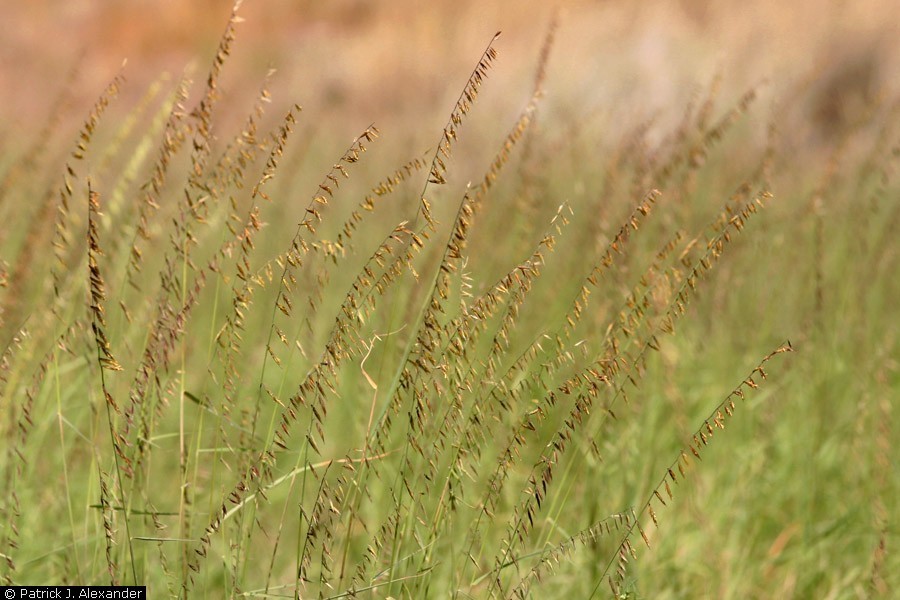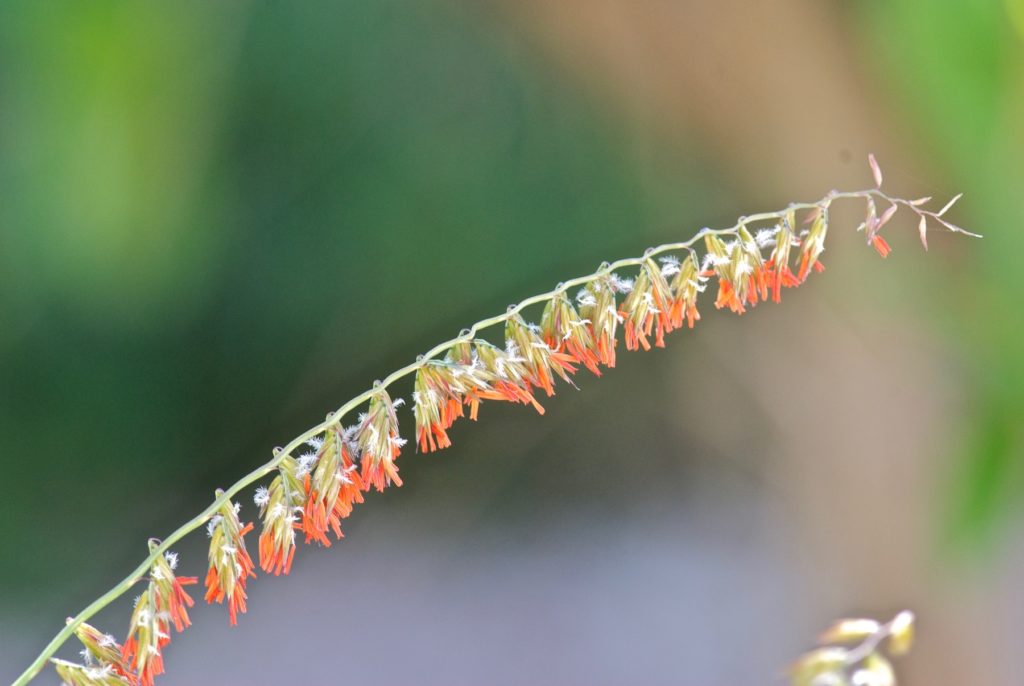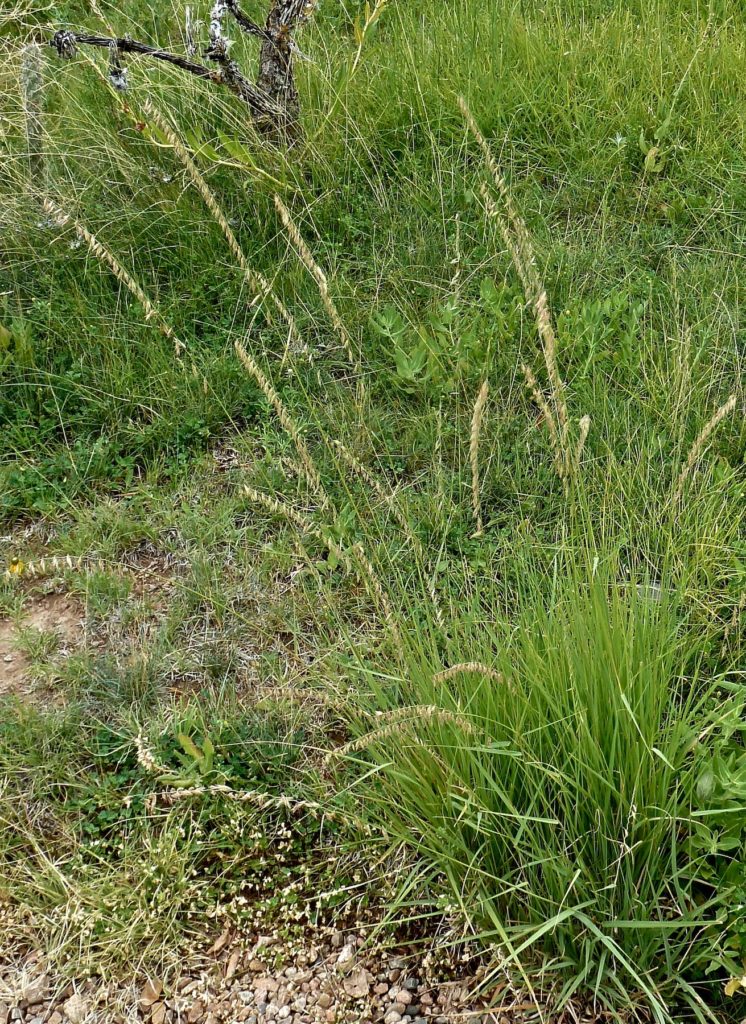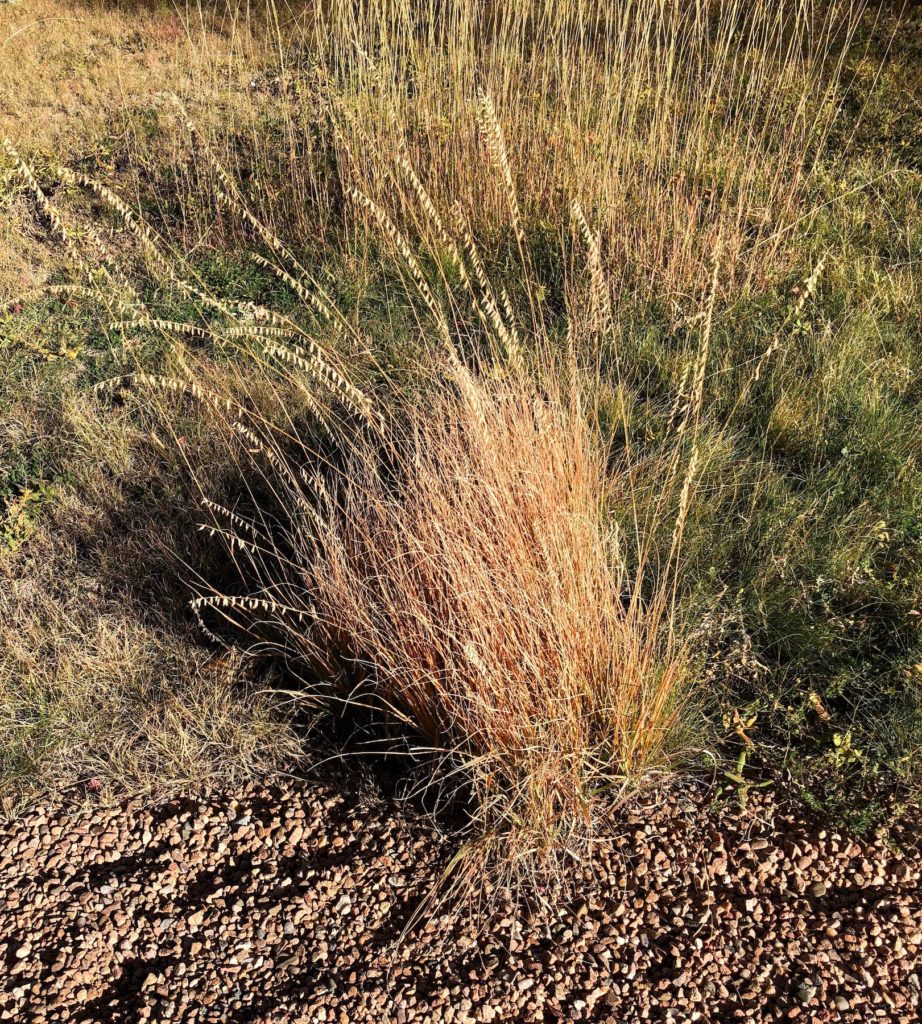Scientific name: Bouteloua curtipendula (Michx.) Torr.
Suggested pronunciation: boo-te-LOO-uh kurt-ih-PEN-dyoo-luh
Varieties: B. curtipendula var. curtipendula and B. curtipendula var. caespitosa
Suggested pronunciation of varieties: kurt-ih-PEN-dyoo-luh, kess-pi-TOH-suh
Common name: sideoats grama (sometimes spelled side-oats)
Family: Poaceae (grass)
Suggested pronunciation: poh-AY-see-ee
USDA Zones: 3-9
Article by Janice Tucker
In July of 1893, Katharine Lee Bates (1859-1929), an American poet and activist, gazed down from atop Pikes Peak near Colorado Springs, Colorado. She was exhausted from her arduous trek up the mountain that reached an elevation of 14,115 feet. But her weariness faded as she gazed out at the magnificence of the sweeping expanse that lay below. The sheer beauty of the sight inspired her to pen the poem “America”, which she later had set to music after adding, “And crown thy good with brotherhood/From sea to shining sea”. The new version, entitled “America the Beautiful”, is one of our country’s most cherished, patriotic songs. Those “amber waves of grain” she immortalized must surely encompass the many native grass varieties endemic to that region of the United States. And if so, the sideoats grama (Bouteloua curtipendula) would be included in the mix. What a lovely thought for those of us who are fortunate to live in an area where the sideoats and other grama grasses thrive. These natives are considered among the “good guys” when it comes to the drought tolerant grasses that flourish in the fields and woodlands of the southwestern states. Texas has chosen sideoats grama as its state grass and the blue grama (B. gracilis) holds that honor in New Mexico and Colorado.

Bouteloua curtipendula, credit: Patrick J. Alexander; hosted by the USDA-NRCS PLANTS Database 29 Nov 2020.
Because of the unique arrangement of its inflorescences (flowers), the sideoats grama often piques curiosity. It is one of the tallest gramas, usually reaching a height of 18 to 24 inches. Thriving in altitudes of 3,000 to 8,000 feet, this warm season, perennial, clump grass has a vase-like structure anchored to the ground by long taproots and short, spreading rhizomes. Alternate, green to blue-green leaves gather at the bottom of aerial stems (culms) that bear the inflorescence. From late spring into late fall, the spiky, alternately-spaced, colorful florets dance in the breeze as they dangle from one side of the arching stems.
The small inflorescences may be somewhat on the subtle side but are definitely worth seeking out. Each spikelet has two bracts and two florets -one fertile and one sterile. The brownish to red anthers and fluffy. white stigmas of the fertile floret coordinate beautifully with the the spikes’ various colors of green, red or purple. The oat-like seed heads that follow the bloom, combined with the sideways seed head arrangement give the plant its common name of sideoats grama. Propagation is fostered when the spikes turn a straw color and are either carried away by the wind or fall to the ground to provide food for birds and small mammals. Spreading rhizomes establish grassy stands, which assist the seeds in species reproduction.

Sideoats grama inflorescence, credit: Janice Tucker.
Like all Bouteloua species, the B. curtipendula is native to the United States, Canada, Mexico and parts of Central and South America. In addition to the species, there are two weaker varieties of the Bouteloua curtipendula – B. curtipendula var. curtipendula and B. curtipendula var. caespitosa. The curtipendula variety is prevalent in the northern segment of the species range, from the southwestern United States to Canada. It spreads mostly by rhizomes and is shorter than the caespitosa variety. The taller caespitosa primarily remains in the southern area of the range, from the southwestern United States to South America. It is a bunch grass, not as rhizomatous and mainly propagated by seed. Preferred habitats of the B. curtipendula include the dryer, mid-grass section of the Great Plains, from dry woods in the eastern United States to desert prairies and piñon-juniper woodlands in the southwestern states – and just maybe in an area near you where it hangs out with other native grasses.
Sideoats grama is a desirable, nutritious forage with a high palatability. The long growing period from summer to fall that sometimes stretches into winter makes it a favorite of ranchers for livestock feed. Pronghorn antelope, mule deer and white-tailed deer are regular browsers. The extended annual growth season helps to sustain these large mammals during the winter months until other fodder becomes available to them.
In addition to forage, sideoats grama is valuable in land management. It is usually mixed with other grasses to control erosion in large, disturbed areas and hillsides. It is not normally considered a fast growing grass but will spread more rapidly when the ground is broken up. Long taproots that reach down to 4 feet prevent it from being uprooted by the ravages of nature. Laterally spreading rhizomes just beneath the surface extend out to 1.5 feet. The combination of the taproots and rhizomes work to keep a fast hold on the soil. Its value is further enhanced by tolerance for harsh weather conditions and adaptation to a variety of soils – even caliche!

Sideoats grama (Bouteloua curtipendula) in summer. Photo credit: Janice Tucker.
Many home gardeners in the southwestern United States often look to nature when choosing plants for wildflower meadows, xeric gardens, bird and butterfly gardens, flower beds and areas with a sloping landscape. Any plant that seems to prefer temperature swings, hot, dry summers, cold winters, high altitudes and is not picky about soil has to grab their attention. The sideoats grama adds a subtle nuance to the garden with its arching stems and dangling spikelets as it gracefully sways in the breeze. Planting can be carried out either by seeding or from ready-to-install pots available in nurseries. Choose the potted option when the goal is specific placement in the garden. Follow seeding instructions when attempting to cover a large area. Plant it in spring or summer in a sunny location. It grows well in sandy, average or dry soil. Once established, water requirements are minimal. Those who live near an open, grassy area should not be surprised if one should volunteer in a garden spot that only Mother Nature could choose. If that happens, try to let it be. No doubt it is in the perfect location, and who wants to argue with Mother Nature? It is a good choice for gardens designed to attract butterflies and moths. At least five types of skipper moths/butterflies (Hesperiidae ssp.) and the veined ctenucha moth (Ctenucha venosa) seek it out as a food source and larval host.

Bouteloua curtipendula in autumn. Photo credit: Janice Tucker.
Since the Bouteloua curtipendula is an important element of the plant life where we reside in the southwestern United States, it behooves us to learn more about its name. The Bouteloua species was named by French botanist, André Michaux (1746-1802) in honor of Spanish gardening brothers Claudio Boutelou (1774-1842) and Esteban Boutelou (1776-1814). American botanist, John Torrey (1796-1873) is credited with designating the specific, curtipendula, a Latin compound word for curtus (shortened) and pendulus (hanging). The variety, caespitosa, means “tufted” which describes a characteristic of one if the plant’s varieties. Although not considered a scientific name, the definition of grama is any species of the Bouteloua genus. The word, grama, is from the Latin, grāmen, which means grass. The plant family, Poaceae, is derived from poa, the ancient Greek name of grass used for fodder.
The sideoats grama along with its siblings in the Bouteloua genus are valuable assets to the landscape of our country whether they grow in the wild or in a pampered home garden. From “sea to shining sea” these noble plants are components of those “amber waves of grain” that make America beautiful.
Many thanks to Helen Woody & Jeanne Gozigian for proofreading this article.
Sources consulted and/or cited:
Allred, Kelly W. “Bouteloua curtipendula – sideoats grama”. A Field Guide to the Grasses of New Mexico.Third Edition. Range Science Herbarium Department of Animal and Range Sciences New Mexico State University. Department of Agricultural Communications, Las Cruces, New Mexico. 2005. Print.
“André Michaux”. Wikipedia. Web. 11 Nov 2020. Accessed 15 Nov 2020. Retrieved from: https://en.wikipedia.org/wiki/André_Michaux.
“Bouteloua curtipendula”. Fire Effects Information System F(FEIS) USDA. Web. 01 Aug 2019. Accessed 24 Sep 2020. Retrieved from: https://www.fs.fed.us/database/feis/plants/graminoid/boucur/all.html#DISTRIBUTION%20AND%20OCCURRENCE.
“Bouteloua curtipendula”. Plant Database. Lady Bird Johnson Wildflower Center. Web. 06 Aug 2019. Accessed 15 Nov 2020. Retrieved from: https://www.wildflower.org/plants/result.php?id_plant=BOCU.
“Bouteloua curtipendula”. Garden Explorer. Santa Fe Botanical Garden. Web/ 23 Nov 2020. Accessed 25 Nov 2020. Retrieved from: https://santafebotanicalgarden.gardenexplorer.org/taxon-291.aspx.
“Bouteloua”. Wikipedia. Web. 28 Jan 2020. Accessed 15 Nov 2020. Retrieved from: https://en.wikipedia.org/wiki/Bouteloua.
“Bouteloua curtipendula”. Wikipedia. Web. 28 Jan 2020. Accessed 14 Sep 2020. Retrieved from: https://en.wikipedia.org/wiki/Bouteloua_curtipendula.
“Ctenucha venos -Veined ctenucha moth”. Wikipedia. Web..22 Jan 2019. Accessed 15 Nov 2020. Retrieved from: https://en.wikipedia.org/wiki/Ctenucha_venosa..
Gay, Charles W. Jr. and Dwyer, Don D. Revision by Allison, Chris, Hatch, Stephan, and Schickedanz, Jerry. “Sideoats Grama-Bouteloua curtipendula (Michx.) Torr.” New Mexico Range Plants. Cooperative Extension Service Circular 374, New Mexico State University. Las Cruces, New Mexico. 2005. Print.
Ivey, Robert Dewitt. “Bouteloua curtipendula – sideoats grama”. Flowering Plants of New Mexico. Fourth Edition. RD & V Ivey, Albuquerque, New Mexico. 2003. Print.
“John Torrey”. Wikipedia Web. 11 Nov 2020. Accessed 15 Nov 2020. Retrieved from: https://en.wikipedia.org/wiki/John_Torrey.
“Sideoats Grama Grass”. High Country Gardens. Web. 2019. Accessed 29 Nov 2020. Retrieved from:
https://www.highcountrygardens.com/perennial-plants/ornamental-grass/sideoats-grama-grass-bouteloua.
“Sideoats Grama- Bouteloua curtipendula (Michx) Torr”. https://plants.usda.gov/plantguide/pdf/pg_bocu.pdf. Accessed 03 Sep 2020.
“Skipper (butterfly)”. Wikipedia. Web. 10 Nov 2020. Accessed 29 Nov 2020. Retrieved from: https://en.wikipedia.org/wiki/Skipper_(butterfly).
Wasowski, Sally. “Bouteloua curtipendula – sideoats grama”. Native Gardening in Northern new Mexico – Taos, Santa Fe, Los Alamos and Other N. M. Highlands. Native Plant Society of New Mexico. 2003. Print.
Westervelt, Eric. “Greatness Is Not a Given: ‘America The Beautiful’ Asks How We Can Do Better – American Anthem Music That Challenges, Unites And Celebrates”. National Public Radio. Web. 04 Aug 2019. Accessed 04 Nov 2020. Retrieved from: https://www.npr.org/2019/04/04/709531017/america-the-beautiful-american-anthem.


